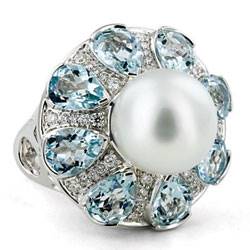|
Pearls
Articles from PEARL JEWELLERY (380 Articles), PEARLS - LOOSE / TEMPORARILY STRUNG (37 Articles), PEARLS - STRANDS (31 Articles)

A South Sea pearl
South Sea Pearls – The Facts
 5.8 k views | Posted August 01, 2009 5.8 k views | Posted August 01, 2009 |
A South Sea pearl is pearl produced by the Pinctada maxima mollusk.
They are currently cultured in areas throughout the Indian and Pacific
Oceans, primarily in Australia, the Philippines, Indonesia and Myanmar.
South Sea Pearls - Among The Largest In The World
South Sea pearls are among the largest commercially harvested cultured pearls in the world. The average size of a South Sea pearl is 13 mm, with most harvests producing a range of sizes from 9 mm to 20 mm.
The South Seas lie between the northern coast of Australia and the southern coast of China. These waters are the native habitat of a large oyster known as Pinctada maxima. This oyster grows up to 12 inches in diameter, and can be nucleated with a much larger bead than other saltwater oysters such as the akoya.
South Sea Pearls Come From Two Varieties Of Pearl-Producing Mollusks
There are two varieties of Pinctada maxima, the silver-lipped and the gold-lipped. The two are distinguished by their distinct coloration of the outer edge of the interior. This type of shell is also known as mother-of-pearl, and is responsible for the coloration of the cultured pearls produced, therefore the name.
Unlike the akoya oyster, the South Sea oyster will only accept one nucleation at a time. The oyster is nucleated when it is only about half developed, from 4.7 inches to 6.7 inches in size, or about 24 months old. Although the South Sea oyster will only handle one nucleus at a time, this oyster (like the Tahitian pearl producing Pinctada margaritifera) can be nucleated up to three times over the course of many years.
Why South Sea Pearls Grow So Large
There are four reasons South Sea pearls can grow to such large sizes, dwarfing many of their other saltwater pearl counterparts. These reasons are: the large size of the Pinctada maxima, the size of the implanted bead, the length of time the pearl is left to grow in the oyster, and the oyster's environment. Due to the size of the oyster, it is able to accept a large bead.
The gonad of the Pinctada maxima is several times larger than that of the akoya. Because of this larger gonad, the South Sea oyster deposits nacre around the nucleus at a much quicker rate, especially in warm water, which speeds the oyster's metabolism._
The South Seas are also extremely clean, and filled with plankton - the Pinctada maxima's favorite food source. The clean waters and abundant food supply also speeds the nacre production. The growth period for South Sea pearls is also substantially longer than that of the akoya. Akoya pearls are harvested after only 9-16 months, where as South Sea pearls are harvested after a minimum of two years allowing for a larger size.
What Makes South Sea Pearls So Unique
South Sea pearls have several distinct characteristics that are unique to this gem. The nacre is unusually thick, ranging from 2 - 6 mm, compared to the 0.35 - 0.7 mm of an akoya pearl. South Sea pearls have a unique, satiny luster that comes from the rapidly deposited nacre and warm waters of the South Seas. South Sea pearls also have a subtle array of colors; typically white, silver, and golden, that are rare in other pearl types.
More information: http://www.pearl-guide.com
|
|
|
|